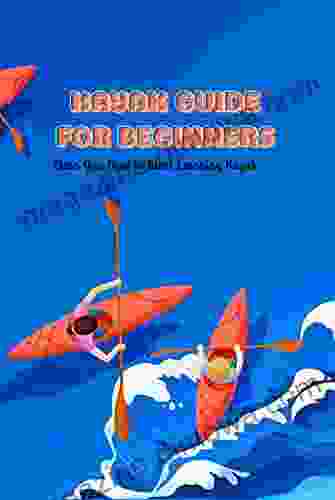The Ultimate Guide to Kayaking Gear: Everything You Need to Get Started

Are you planning to learn how to kayak? If so, you're going to need the right gear. In this article, we'll cover everything you need to know about choosing the right kayak, paddle, life jacket, dry suit, helmet, and shoes.
Kayak
The first step in choosing a kayak is to decide what type of kayaking you'll be ng. There are three main types of kayaks: recreational kayaks, touring kayaks, and whitewater kayaks. Recreational kayaks are the most stable and easiest to paddle, making them a good choice for beginners. Touring kayaks are longer and narrower than recreational kayaks, and they're designed for longer trips. Whitewater kayaks are designed for paddling in rough water, and they're typically shorter and wider than other types of kayaks.
4.3 out of 5
| Language | : | English |
| File size | : | 25156 KB |
| Text-to-Speech | : | Enabled |
| Screen Reader | : | Supported |
| Enhanced typesetting | : | Enabled |
| Print length | : | 58 pages |
| Lending | : | Enabled |
Once you've decided what type of kayaking you'll be ng, you can start to narrow down your choices. There are a few things to keep in mind when choosing a kayak:
- Length: The length of a kayak determines how fast and maneuverable it will be. Longer kayaks are faster and more stable, but they're also more difficult to maneuver. Shorter kayaks are more maneuverable, but they're not as fast or stable.
- Width: The width of a kayak determines how stable it will be. Wider kayaks are more stable, but they're also slower and less maneuverable. Narrower kayaks are faster and more maneuverable, but they're not as stable.
- Material: Kayaks are made from a variety of materials, including plastic, fiberglass, and carbon fiber. Plastic kayaks are the most durable and affordable, but they're also the heaviest. Fiberglass kayaks are lighter than plastic kayaks, and they're also more durable. Carbon fiber kayaks are the lightest and most durable, but they're also the most expensive.
Paddle
The next piece of gear you'll need is a paddle. Kayaking paddles come in a variety of shapes and sizes, so it's important to choose one that's the right size and shape for you. The length of the paddle will depend on your height and the type of kayaking you'll be ng. The shape of the paddle will depend on your paddling style.
Here are a few things to keep in mind when choosing a kayak paddle:
- Length: The length of the paddle should be about 10 inches shorter than your height.
- Shape: The shape of the paddle will depend on your paddling style. There are two main types of kayak paddles: flat paddles and feathered paddles. Flat paddles are the most common type of paddle, and they're a good choice for beginners. Feathered paddles are more efficient than flat paddles, but they require more skill to use.
- Material: Kayak paddles are made from a variety of materials, including aluminum, fiberglass, and carbon fiber. Aluminum paddles are the most durable and affordable, but they're also the heaviest. Fiberglass paddles are lighter than aluminum paddles, and they're also more durable. Carbon fiber paddles are the lightest and most durable, but they're also the most expensive.
Life Jacket
A life jacket is one of the most important pieces of safety gear you can have when kayaking. It can help keep you afloat if you fall out of your kayak, and it can also protect you from the elements. When choosing a life jacket, it's important to make sure that it's the right size and type for you.
Here are a few things to keep in mind when choosing a life jacket:
- Size: The life jacket should fit snugly but not too tightly. It should not ride up above your chin or down below your waist.
- Type: There are two main types of life jackets: Type I and Type III. Type I life jackets are designed for rough water and offshore boating. Type III life jackets are designed for calm water and inland boating.
- Features: Some life jackets come with additional features, such as pockets, whistles, and reflective tape. These features can be useful, but they're not essential.
Dry Suit
A dry suit is a waterproof garment that can help keep you warm and dry when kayaking in cold water. Dry suits are typically made from neoprene or Gore-Tex, and they can range in price from a few hundred dollars to over a thousand dollars. If you're planning to kayak in cold water, a dry suit is a good investment.
Here are a few things to keep in mind when choosing a dry suit:
- Size: The dry suit should fit snugly but not too tightly. It should not restrict your movement or cause any discomfort.
- Material: Dry suits are typically made from neoprene or Gore-Tex. Neoprene is a less expensive material, but it's not as breathable as Gore-Tex. Gore-Tex is a more expensive material, but it's more breathable and durable.
- Features: Some dry suits come with additional features, such as pockets, zippers, and Velcro closures. These features can be useful, but they're not essential.
Helmet
A helmet is an important piece of safety gear for kayaking, especially if you're kayaking in whitewater or on open water. A helmet can help protect your head from bumps and bruises, and it can also help prevent serious injuries in the event of a fall.
When choosing a kayak helmet, it's important to make sure that it fits snugly and that it's comfortable to wear. The helmet should also have a hard outer shell and a soft inner liner. Some helmets also come with additional features, such as vents and ear flaps. These features can be useful, but they're not essential.
Shoes
The last piece of gear you'll need is a pair of kayaking shoes. Kayaking shoes are designed to provide support and protection for your feet when kayaking. They typically have a non-slip sole and a closed toe design. Some kayaking shoes also come with additional features, such as drainage holes and ankle support. These features can be useful, but they're not essential.
When choosing kayaking shoes, it's important to make sure that they fit snugly and that they're comfortable to wear. The shoes should also be made from a durable material that can withstand the rigors of kayaking.
Kayaking is a great way to get exercise, enjoy the outdoors, and have some fun. If you're planning to learn how to kayak, it's important to have the right gear. In this article, we've covered everything you need to know about choosing the right kayak, paddle, life jacket, dry suit, helmet, and shoes. With the right gear, you'll be able to enjoy kayaking safely and comfortably.
4.3 out of 5
| Language | : | English |
| File size | : | 25156 KB |
| Text-to-Speech | : | Enabled |
| Screen Reader | : | Supported |
| Enhanced typesetting | : | Enabled |
| Print length | : | 58 pages |
| Lending | : | Enabled |
Do you want to contribute by writing guest posts on this blog?
Please contact us and send us a resume of previous articles that you have written.
 Book
Book Novel
Novel Page
Page Chapter
Chapter Text
Text Story
Story Genre
Genre Reader
Reader Library
Library Paperback
Paperback E-book
E-book Magazine
Magazine Newspaper
Newspaper Paragraph
Paragraph Sentence
Sentence Bookmark
Bookmark Shelf
Shelf Glossary
Glossary Bibliography
Bibliography Foreword
Foreword Preface
Preface Synopsis
Synopsis Annotation
Annotation Footnote
Footnote Manuscript
Manuscript Scroll
Scroll Codex
Codex Tome
Tome Bestseller
Bestseller Classics
Classics Library card
Library card Narrative
Narrative Biography
Biography Autobiography
Autobiography Memoir
Memoir Reference
Reference Encyclopedia
Encyclopedia Lisa Wheeler
Lisa Wheeler John C Robinson
John C Robinson John H Holland
John H Holland Robert Louis Caldwell
Robert Louis Caldwell Jim Kershner
Jim Kershner Joachim Radkau
Joachim Radkau Michael E Newton
Michael E Newton Sportsman S Connection
Sportsman S Connection John Cameron
John Cameron Jim Schollmeyer
Jim Schollmeyer Joanna S Morris
Joanna S Morris Otura Mercy
Otura Mercy Nicole Glover
Nicole Glover Michelle Major
Michelle Major John Archibald Wheeler
John Archibald Wheeler Jimmy Stockin
Jimmy Stockin Jim Volz
Jim Volz John Waterbury
John Waterbury Johnpaul Sahagian
Johnpaul Sahagian Jim Garland
Jim Garland
Light bulbAdvertise smarter! Our strategic ad space ensures maximum exposure. Reserve your spot today!
 Giovanni MitchellFollow ·4.9k
Giovanni MitchellFollow ·4.9k Joel MitchellFollow ·19.9k
Joel MitchellFollow ·19.9k Nathaniel PowellFollow ·10.6k
Nathaniel PowellFollow ·10.6k Stephen FosterFollow ·4.6k
Stephen FosterFollow ·4.6k Gavin MitchellFollow ·18.5k
Gavin MitchellFollow ·18.5k J.R.R. TolkienFollow ·17.7k
J.R.R. TolkienFollow ·17.7k Herman MitchellFollow ·12.7k
Herman MitchellFollow ·12.7k Jarrett BlairFollow ·16.2k
Jarrett BlairFollow ·16.2k

 Joshua Reed
Joshua ReedTake Your Marketing Business Into The Next Level
Are you ready to...

 Aaron Brooks
Aaron BrooksFrom Fourier to Cauchy-Riemann: Geometry Cornerstones
From Fourier to Cauchy-Riemann: Geometry...

 Orson Scott Card
Orson Scott CardUnveiling the Art of Mitigation Banking: A Comprehensive...
In the intricate dance between...

 Victor Hugo
Victor HugoUnleash Your Creativity: A Journey Through the Enchanting...
Prepare to be captivated as we...

 Duncan Cox
Duncan CoxLoad of Bull: An Englishman's Adventures in Madrid
By Simon Bunce ...
4.3 out of 5
| Language | : | English |
| File size | : | 25156 KB |
| Text-to-Speech | : | Enabled |
| Screen Reader | : | Supported |
| Enhanced typesetting | : | Enabled |
| Print length | : | 58 pages |
| Lending | : | Enabled |














